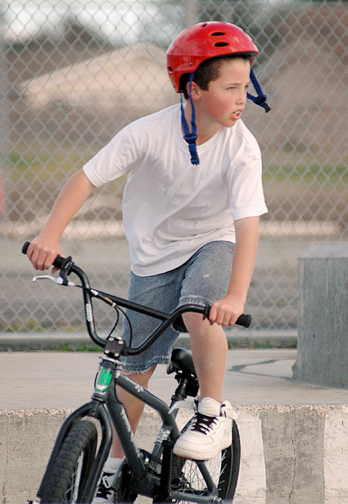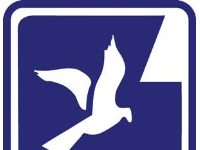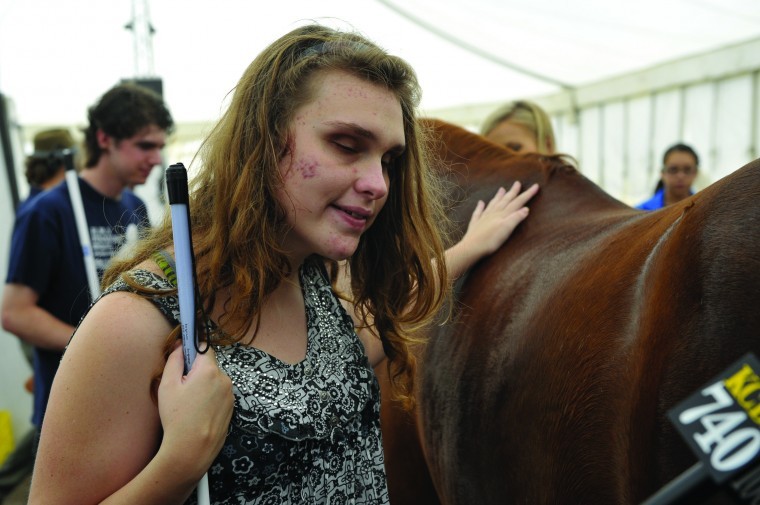
Helmets are given away in some local cities, so why are children
still dying?
A traffic accident on Feb. 20 took the life of five-year-old
Devon Estrada. The boy was riding his bicycle unsupervised and
without a helmet when he was struck by a car.
Estrada’s death was tragic and neighbors in the Sunnyslope
Village area are attempting to get more speed-reducing devices
implemented, but the reality is slower speeds may not have saved
Devon’s life.
Helmets are given away in some local cities, so why are children still dying?
A traffic accident on Feb. 20 took the life of five-year-old Devon Estrada. The boy was riding his bicycle unsupervised and without a helmet when he was struck by a car.
Estrada’s death was tragic and neighbors in the Sunnyslope Village area are attempting to get more speed-reducing devices implemented, but the reality is slower speeds may not have saved Devon’s life.
An increasing number of children are riding their bicycles, skateboards and scooters without helmets every day, and the result, as tragic as it is, might be inevitable. Unprotected human skulls were never designed to withstand the impact of a ton of moving steel or a 12-foot fall onto concrete from a BMX jump.
Helmets have been shown to reduce risks by as much as 85 percent and risks of brain injury by as much as 88 percent, according to statistics provided by the advocacy group Safe Kids USA. Helmets have also been shown to offer substantial protection to the forehead and mid-face. Safe Kids estimated that 75 percent of bike related fatalities among children could have been prevented with bicycle helmets.
Helmet ownership and use increases with parents’ income and educational level, yet decrease with age – the older the child, the less likely they are to wear a helmet. Children are also more likely to wear helmets if they are riding with others who are wearing helmets.
Hollister is one of the cities in the area that has no program to educate youth on bicycle safety. Since the Hollister Police Department has no crime-prevention budget, its does not have the ability to conduct safety outreach in the community. Hollister Chief of Police Jeff Miller said his department lacks the manpower to enforce existing bike helmet laws.
“We depend on our best weapon, the media, for getting the word out there,” Miller said. “We want parents to read this and realize that they need to make sure their children wear helmets.”
Miller has worked for several departments in the past that utilized some creative methods for enforcing helmet use. Some of those methods including issuing citations and requiring youth to go through a bicycle safety course before the citation could be removed.
“A lot of things could be done, but with limited resources, the media is our best tool at this point,” Miller said. “Ask Lance Armstrong if he ever rides without a helmet; they ride with helmets for a reason. The same goes for skaters.”
Hollister police say they do what they can, but often police see kids without helmets while they are engaged in another call.
“Maybe my officers are tailing a suspect or engaged looking for speeders and it is not always possible. They do what they can, but it’s not always possible to stop everyone they see,” Miller said. “It’s not a matter of priorities, but if the officers are dealing with the skaters at the skatepark, then they’re not dealing with the gangs; and if they’re dealing with the gangs, they’re not dealing with the traffic problems; and if they’re dealing with the traffic problems, they’re not dealing with the burglaries.”
Miller said that this isn’t to say that the department won’t be doubling its efforts to ensure youth safety, but there is only so much that can be done.
“I had one officer that wrote a kid a ticket three times for not wearing a helmet,” he said. “We couldn’t figure out what it was going to take to get him to wear one.”
The Gilroy Police Department has a proactive approach to bicycle helmet enforcement. When Gilroy police are dealing with young children, the officers will issue warnings and often that is enough to deter the violator from repeating the offense. The officers do however have the discretion to write tickets for offenses when they find it necessary.
They also work at educating the youth about the proper ways to ride bicycles and the correct way to wear a helmet, said Gilroy Sergeant Kurt Svardal.
Gilroy Sgt. Daniel Castaneda works with the Neighborhood Resources Unit – the unit that provides community outreach for bicycle safety and puts on presentations for any interested clubs, schools or organizations. They also put on the annual Bicycle Rodeo.
The event is held in late August or early September and facilitated with help from the PD’s bicycle and K-9 units, as well as participation from the California Highway Patrol and the Gilroy Fire Department. The event has been going on for the past 10 years and is usually quite a draw for kids, Castaneda said.
The event usually includes a helmet table where they give out helmets to anyone who shows up without one, a station for checking bicycle maintenance and a licensing table. There is also usually free food provided by one of the local restaurants.
Castaneda said that the main attraction every year is the ‘Safe Moves City’ – that is a mock city four or five feet tall that the police can lay out in a parking lot and physically take kids through the challenges and hazards of riding a bike in the city. The simulator addresses safety issues, including properly crossing a crosswalk and how to avoid dogs.
In order to use the ‘Safe Moves City’ kids have to be wearing their helmets. If a child shows up without a helmet, they are given one and shown the proper way to wear it. Castaneda estimated that at last year’s event they gave out 250 helmets. The department gets the helmets discounted at $3.70 per helmet, so last year they spent $925 on helmets.
Svardal could not recall the last bicycle-related fatality in Gilroy, but said the city does occasionally have injury collisions involving bicycles.
Still, anytime on a given weekend or after school, a drive past the city’s skateboard park in Las Animas Veterans Memorial Park will present a bevy of kids flying off jumps, and few, if any, are wearing helmets.
“We find that when dealing with kids, a big part of determent is education,” Svardal said. Police can only do so much to get kids into helmets. The best enforcement starts at home, Castaneda said.
“It’s the responsibility of the parents to provide helmets,” Castaneda said. “I don’t let my kids out of the house without helmets.”
Up the road in Morgan Hill, police say there have been no recent problems with kids refusing to wear helmets, which is attributed to the department’s educational efforts. The department has a bike-control unit that hands out safety pamphlets, checks bikes for safety and teaches kids how to properly wear helmets. There is usually a bike rodeo at the annual Art a la Carte event put on at the Community Culture Center. Police Commander Joe Sampson reported that he does not recall any recent bicycle-related traffic accidents.
But just wearing a helmet isn’t enough; it has to be worn properly. A study by pediatricians in Falmouth, Mass. tested the ability of kids and parents to securely fit helmets. It concluded that most did not fit them well, with only 4 percent passing the study’s full standards.
Fitting a helmet properly is a problem for all ages, not just for kids, according to the Bicycle Helmet Safety Institute, based in Washington, D.C. The BHSI tested the results from the Massachusetts study and found that 80 percent failed the maximum helmet stability test – one inch of movement front to back or side to side. The data corresponds to what the BHSI hears from bike rodeo fitters and others in the field that deal with kids showing up at events with sloppy-fitted helmets.
BHSI insists that with 80 percent of wearers not securing their helmets properly, manufacturers need to make a greater effort to design helmets that fit more easily.
While it’s too late for Devon Estrada and his family, the young boy’s legacy could be to shine a light on the issue of helmet safety.
The following are a list of suggested guidelines for buying and fitting helmets.
Always buy helmets that bare a label saying it meets the American National Standards Institute (ANSI) standards, the Snell Memorial Foundation standard, or the American Society of Testing Materials (ASTM) standard.
Always wear helmets flat atop your head; do not wear them tilted back at an angle.
Always make sure that the helmet fits snugly and does not obscure your field of vision.
Parents, always make sure to help young riders adjust their helmets to the correct specifications.
Always make sure to wear the helmet with the chin-strap firmly buckled. Make sure the chin-strap fits securely and that the buckle stays fastened to provide impact protection. No combination of twisting or pulling should remove the helmet from the head or loosen the buckle on top.
Do not use a helmet after it has been involved in an accident. Damage to the helmet may not be visible to an untrained eye. Even small cracks in the helmet may greatly reduce a helmet’s effectiveness in injury prevention. Either destroy the helmet and get a new one or have it inspected by the manufacturer. The manufacturer will tell you if the helmet needs replacing.
A good rule of thumb is that the more air vents a helmet has, the less foam there is to protect the head.
Additionally there are several tips for staying safe when riding a bicycle. In order to properly see and be seen, always wear bright, florescent colors.
Avoid biking after dark, or if you have to ride after dark, equip your bike with head and tail lights and wear reflective clothing.
Stay alert. Look for obstacles in your path.
Always remember to ride with traffic.
Always check traffic, be aware of those around you.
Learn the rules of the road and obey the traffic laws.
Ensure bike readiness – always make sure that your bike is properly adjusted, including checking the brakes and the wheels. Quick release wheels should always be securely fastened.
If you are using your helmet for skating, skateboarding or riding a scooter, make sure the helmet meets the ASTM standards.







